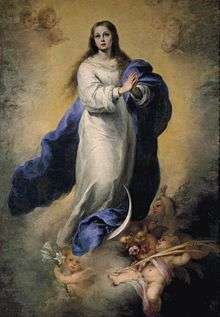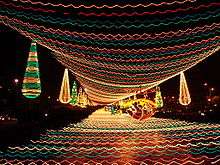Day of the Little Candles
Little Candles Day (Spanish: Día de las velitas) is one of the most observed traditional holidays in Colombia. It is celebrated on December 7, on the eve of the Immaculate Conception, which is a public holiday in Colombia. This day is the unofficial start of the Christmas season in the country.[1]
| Día de las velitas Little Candles Day | |
|---|---|
 Paper lanterns in Quimbaya, Quindío. | |
| Official name | Day of the Immaculate Conception |
| Observed by | Colombia and Lyon |
| Type | State and religious |
| Celebrations | Lighting of candles and lanterns |
| Observances | Various religious processions |
| Begins | Sundown December 7 |
| Ends | Sunrise December 8 |
| Date | December 7 |
| Next time | 7 December 2020 |
| Frequency | annual |
| Related to | Christmas in Colombia |
On this night, people place candles and paper lanterns on windowsills, balconies, porches, sidewalks, streets, parks and squares; in short, everywhere they can be seen, in honor of the Virgin Mary and her Immaculate Conception. On December 8 it is customary for houses to hoist a white flag with the image of the Virgin Mary all day. They also hold numerous events, from firework shows to competitions.
Background

The celebration of the Night of the Little Candles dates to December 7, 1854, when Pope Pius IX defined as dogma the Immaculate Conception of the Virgin Mary, published in his Apostolic constitution Ineffabilis Deus. In anticipation of this decision, people lit candles and paper lanterns to show their support and belief in this idea.
In Colombia, as in many places all over the world, this announcement was observed by lighting candles. The Catholic Church of Colombia kept alive the celebration and made an annual tradition of lighting candles the night of December 7.[2]
Some places celebrate the night of the little candles several nights before December 8, particularly in the Paisa region. This is believed to derive from a hanukkah tradition since a large number of paisas are from Jewish descent.[3] This can be affirmed with the beginning of the Novenas in which thru the 16th of December families gather and give aguinaldos, presents, to each other, similar to the Hanukkah celebration.
Traditions

El Día de las Velitas is celebrated throughout Colombia, but traditions vary in each region and city.
In the municipality of Quimbaya, in Quindío Department the most important cultural event is the Candles and Lanterns Festival (full name in Spanish: Fiesta Nacional del Concurso de Alumbrados con Velas y Faroles), which began in 1982 and is held each year on 7 and 8 December. Each of the neighborhoods in the township competes to produce the most spectacular lighting arrangements, and many visitors come from throughout Colombia to admire the displays.

The Quimbayan Christmas Panther is an indigenous figure recognized by native and mestizo communities in the Quindío Department of Colombia. Belief in the Christmas Panther (el puma de navidad) has developed throughout the history of the Quimbayan holiday known as the Alumbrado de Navidad (see Feast of the Immaculate Conception), celebrated on the 7th of December in recognition of the Roman Catholic belief in the Immaculate Conception of the Blessed Virgin Mary. It is believed that the significance of the puma stems from the arrival of ethnically Spanish colonialists from Antioquia in the region during the 1850s. The colonialist's Catholic traditions of using candlelight to celebrate the Immaculate Conception was combined with belief of the local Quimbaya tribe in the effect that fire (luces de fogota) had in protecting against panther attacks as pumas and other local fauna are believed to fear fire. Thus, in an instance of religious syncretism, the Alumbrado de Navidad and the symbolism of the puma to native peoples were linked. It is still a common occurrence to display the symbol of the panther (in the form of sculptures made of terra cotta, cloth, plastic, etc.) in conjunction with the lighting of candles on the night of December the 7th. Such religious syncretism is especially visible in the rural pueblos of Quindio where many residents claim full or partial descent from Quimbaya native peoples of the region.
In Bogotá, the Christmas decorations reach their peak on this day; the city, fully decorated, plans late activities for the whole family since most Colombians would be out and about admiring the shows, many streets close to traffic and allow pedestrians to walk freely and stop to admire the light arrangements. Malls, museums, stores, and other public places have extended hours of operation. There are many shows that take place on this night, live nativity scenes, caroling events, among others.
In the Caribbean region of Colombia, the lighting of candles and lanterns takes place on the early hours of December 8, before sunrise, instead of the night before. Devout Catholics wake up before sunrise and light candles with their family members. Many people decide to stay up all night and party in celebration and light the candles sometime before they retreat to bed. Families meet to celebrate the day and along with lighting the candles, there is abundant food and drinks. An evening that brings extended families groups together to talk during the evening.
In Cali, Valle del Cauca people also walk along the Cali River that is illuminated for the season.
See also
References
- "Con Las Velitas Se Prende La Navidad". El Tiempo (in Spanish). 6 December 2003. Retrieved 25 November 2008.
- Guarín Claudia Toro, Lina. "Una fiesta alrededor de la luz" (in Spanish). El Colombiano. Retrieved 6 December 2011.
- "Cripto-Judios de Colombia".